Influence of Fiber Type and Length on Mechanical Properties of MICP-Treated Sand
Abstract
:1. Introduction
2. Test Material
2.1. Experimental Bacteria
2.2. Experimental Fiber
2.3. Sand for Test
2.4. Specimen Preparation
2.5. Preparation of Nutrient Solution
3. Experimental Test Methods
3.1. Determination of Permeability Coefficient
3.2. Determination of Water Absorption
3.3. Determination of Dry Density
3.4. UCS Test
3.5. Determination of Calcium Carbonate Content
3.6. SEM Test
4. Results and Discussion
4.1. Physical Properties
4.2. Mechanical Properties
4.3. Microstructural Features
5. Conclusions
- (1)
- In microbial cured sand, reinforcement with short fibers has an effect of promoting the precipitation of calcium carbonate. The precipitation of calcium carbonate is negatively correlated with water absorption rate and positively correlated with dry density.
- (2)
- Fiber length has an important effect on the mechanical properties of microbial cured sand soil. UCS increases first and then decreases with increased fiber length. When the length of polypropylene, glass, and polyethylene fibers is 9 mm and the length of basalt fibers is 12 mm, MICP has the best effect on sand samples.
- (3)
- The effect of fiber type is greater than that of fiber length.
- (4)
- The UCS of different fibers varies, and the strength, from lowest to highest, is basalt fiber < polypropylene fiber < glass fiber < polyvinyl alcohol fiber.
Author Contributions
Funding
Institutional Review Board Statement
Informed Consent Statement
Data Availability Statement
Conflicts of Interest
References
- Liu, B.; Zhu, C.; Tang, C.S.; Xie, Y.H.; Yin, L.Y.; Cheng, Q.; Shi, B. Bio-remediation of desiccation cracking in clayey soils through microbially induced calcite precipitation (MICP). Eng. Geol. 2020, 264, 105389. [Google Scholar] [CrossRef]
- Anbu, P.; Kang, C.H.; Shin, Y.J.; So, J.S. Formations of calcium carbonate minerals by bacteria and its multiple applications. SpringerPlus 2016, 5, 715–733. [Google Scholar] [CrossRef] [Green Version]
- Zhao, Y.; Zhang, P.P.; Fang, H.Y.; Guo, C.C.; Zhang, B.B.; Wang, F.M. Bentonite-assisted microbial-induced carbonate precipitation for coarse soil improvement. Bull. Eng. Geol. Environ. 2021, 80, 5623–5632. [Google Scholar] [CrossRef]
- Zhao, Y.; Yao, J.; Yuan, Z.M.; Wang, T.Q.; Zhang, Y.Y.; Wang, F. Bioremediation of Cd by strain GZ-22 isolated from mine soil based on biosorption and microbially induced carbonate precipitation. Environ. Sci. Pollut. Res. 2017, 24, 372–380. [Google Scholar] [CrossRef] [PubMed]
- Choi, S.G.; Wang, K.J.; Wen, Z.Y.; Chu, J. Mortar crack repair using microbial induced calcite precipitation method. Cem. Concr. Compos. 2017, 83, 209–221. [Google Scholar] [CrossRef]
- Liu, S.Y.; Wang, R.K.; Yu, J.; Peng, X.Q.; Cai, Y.Y.; Tu, B.X. Effectiveness of the anti-erosion of an MICP coating on the surfaces of ancient clay roof tiles. Constr. Build. Mater. 2020, 243, 118202. [Google Scholar] [CrossRef]
- Mu, B.G.; Gui, Z.Y.; Lu, F.; Petropoulos, E.; Yu, Y.J. Microbial-Induced Carbonate Precipitation Improves Physical and Structural Properties of Nanjing Ancient City Walls. Materials 2021, 14, 5665. [Google Scholar] [CrossRef]
- Zamani, A.; Xiao, P.; Baumer, T.; Carey, T.J.; Sawyer, B.; DeJong, J.T.; Boulanger, R.W. Mitigation of Liquefaction Triggering and Foundation Settlement by MICP Treatment. J. Geotech. Geoenviron. Eng. 2021, 147, 04021099. [Google Scholar] [CrossRef]
- Meng, H.; Gao, Y.F.; He, J.; Qi, Y.S.; Hang, L. Microbially induced carbonate precipitation for wind erosion control of desert soil: Field-scale tests. Geoderma 2021, 383, 114723. [Google Scholar] [CrossRef]
- Phillips, A.J.; Cunningham, A.B.; Gerlach, R.; Hiebert, R.; Hwang, C.C.; Lomans, B.P.; Westrich, J.; Mantilla, C.; Kirksey, J.; Esposito, R.; et al. Fracture Sealing with Microbially-Induced Calcium Carbonate Precipitation: A Field Study. Environ. Sci. Technol. 2016, 50, 4111–4117. [Google Scholar] [CrossRef] [Green Version]
- Ngu, L.H.; Song, J.W.; Hashim, S.S.; Ong, D.E. Lab-scale atmospheric CO2 absorption for calcium carbonate precipitation in sand. Greenh. Gases-Sci. Technol. 2019, 9, 519–528. [Google Scholar] [CrossRef]
- Zhao, Q.; Li, L.; Li, C.; Li, M.D.; Amini, F.; Zhang, H.Z. Factors Affecting Improvement of Engineering Properties of MICP-Treated Soil Catalyzed by Bacteria and Urease. J. Mater. Civ. Eng. 2014, 26, 04014094. [Google Scholar] [CrossRef]
- Wang, X.R.; Li, C.; Fan, W.H.; Li, H.Y. Reduction of Brittleness of Fine Sandy Soil Biocemented by Microbial-Induced Calcite Precipitation. Geomicrobiol. J. 2022, 39, 135–147. [Google Scholar] [CrossRef]
- Fang, X.W.; Yang, Y.; Chen, Z.; Liu, H.L.; Xiao, Y.; Shen, C.N. Influence of Fiber Content and Length on Engineering Properties of MICP-Treated Coral Sand. Geomicrobiol. J. 2020, 37, 582–594. [Google Scholar] [CrossRef]
- Cheng, L.; Shahin, M.A.; Mujah, D. Influence of Key Environmental Conditions on Microbially Induced Cementation for Soil Stabilization. J. Geotech. Geoenviron. Eng. 2017, 143, 04016083. [Google Scholar] [CrossRef] [Green Version]
- Li, M.D.; Li, L.; Ogbonnaya, U.; Wen, K.J.; Tian, A.G.; Amini, F. Influence of Fiber Addition on Mechanical Properties of MICP-Treated Sand. J. Mater. Civ. Eng. 2016, 28, 04015166. [Google Scholar] [CrossRef]
- Al Imran, M.; Gowthaman, S.; Nakashima, K.; Kawasaki, S. The Influence of the Addition of Plant-Based Natural Fibers (Jute) on Biocemented Sand Using MICP Method. Materials 2020, 13, 4198. [Google Scholar] [CrossRef]
- Choi, S.G.; Wang, K.J.; Chu, J. Properties of biocemented, fiber reinforced sand. Constr. Build. Mater. 2016, 120, 623–629. [Google Scholar] [CrossRef]
- Zhao, Y.; Xiao, Z.Y.; Fan, C.B.; Shen, W.Q.; Wang, Q.; Liu, P.H. Comparative mechanical behaviors of four fiber-reinforced sand cemented by microbially induced carbonate precipitation. Bull. Eng. Geol. Environ. 2020, 79, 3075–3086. [Google Scholar] [CrossRef]
- Feiyu, L.; Jiaxi, T.; Guohui, Y.; Jun, W.; Hongtao, F. Experimental study on the treatment of dredged sludge by fiber-reinforced optimized electroosmosis method. Chin. J. Rock Mech. Eng. 2021, 40, 2545–2552. [Google Scholar]
- Orakoglu, M.E.; Liu, J.K.; Niu, F.J. Dynamic behavior of fiber-reinforced soil under freeze-thaw cycles. Soil Dyn. Earthq. Eng. 2017, 101, 269–284. [Google Scholar] [CrossRef]
- Choi, S.G.; Hoang, T.; Park, S.S. Undrained Behavior of Microbially Induced Calcite Precipitated Sand with Polyvinyl Alcohol Fiber. Appl. Sci. 2019, 9, 1214. [Google Scholar] [CrossRef] [Green Version]
- Pastsuk, V.; Kiisk, M.; Lohmus, R.; Merisalu, M.; Kovaljov, S.; Biland, A.; Gulik, V. Selection of basalt fiber with resistance to concrete alkaline environment. SN Appl. Sci. 2020, 2, 17. [Google Scholar] [CrossRef]
- Zhao, J.T.; Tong, H.W.; Shan, Y.; Yuan, J.; Peng, Q.W.; Liang, J.L. Effects of Different Types of Fibers on the Physical and Mechanical Properties of MICP-Treated Calcareous Sand. Materials 2021, 14, 268. [Google Scholar] [CrossRef]
- Ruimin, C.; Wenbin, J.; Xiaofang, Z.; Zehua, F. Experimental study on the performance of CSFG-FR synergistic improvement of silt-cured soil. Geotechnics 2022, 43, 1020–1030. [Google Scholar] [CrossRef]
- GB/T 50123-2019; Geotechnical Test Method Standards. Standardization Administration of China: Beijing, China, 2019; p. 717.
- Wen, K.J.; Li, Y.; Liu, S.H.; Bu, C.M.; Li, L. Development of an Improved Immersing Method to Enhance Microbial Induced Calcite Precipitation Treated Sandy Soil through Multiple Treatments in Low Cementation Media Concentration. Geotech. Geol. Eng. 2019, 37, 1015–1027. [Google Scholar] [CrossRef]
- Yao, D.F.; Wu, J.; Wang, G.W.; Wang, P.B.; Zheng, J.J.; Yan, J.Y.; Xu, L.; Yan, Y.J. Effect of wool fiber addition on the reinforcement of loose sands by microbially induced carbonate precipitation (MICP): Mechanical property and underlying mechanism. Acta Geotech. 2021, 16, 1401–1416. [Google Scholar] [CrossRef]
- Liu, S.H.; Wen, K.J.; Armwood, C.; Bu, C.M.; Li, C.; Amini, F.; Li, L. Enhancement of MICP-Treated Sandy Soils against Environmental Deterioration. J. Mater. Civ. Eng. 2019, 31, 13. [Google Scholar] [CrossRef]
- Li, L.; Wen, K.J.; Bu, C.M.; Amini, F. Enhancement of Bio-Sandy Brick through Discrete Randomly Distributed Fiber. In Proceedings of the Geo-Congress on Biogeotechnics, Minneapolis, MN, USA, 25–28 February 2020; pp. 39–45. [Google Scholar]
- Spencer, C.A.; van Paassen, L.; Sass, H. Effect of Jute Fibres on the Process of MICP and Properties of Biocemented Sand. Materials 2020, 13, 5429. [Google Scholar] [CrossRef] [PubMed]
- Divya, P.V.; Viswanadham, B.V.S.; Gourc, J.P. Evaluation of Tensile Strength-Strain Characteristics of Fiber-Reinforced Soil through Laboratory Tests. J. Mater. Civ. Eng. 2014, 26, 14–23. [Google Scholar] [CrossRef]
- Tran, K.Q.; Satomi, T.; Takahashi, H. Effect of waste cornsilk fiber reinforcement on mechanical properties of soft soils. Transp. Geotech. 2018, 16, 76–84. [Google Scholar] [CrossRef]
- Yang, Y.; Shiyuan, H.; Yuzhe, D.; Chuan, L. Experimental study of type I fracture toughness of fiber reinforced clay. People’s Yangtze River 2021, 52, 291–295. [Google Scholar]
- Lei, X.W.; Lin, S.Q.; Meng, Q.S.; Liao, X.H.; Xu, J.P. Influence of different fiber types on properties of biocemented calcareous sand. Arab. J. Geosci. 2020, 13, 317. [Google Scholar] [CrossRef]
- Yang, B.; Weng, X.; Liu, J.; Kou, Y.; Jiang, L.; Li, H.; Yan, X. Mechanical properties of modified polypropylene fibers and cement reinforced loess. J. Constr. Mater. 2016, 19, 694–701. [Google Scholar]
- Hu, C.; Weng, X.; Zhang, J.; Gao, R.; Lu, C. Experimental study on compressive performance of multi-scale fiber reinforced cement soil. Road Traffic Technol. 2020, 37, 16–24. [Google Scholar]

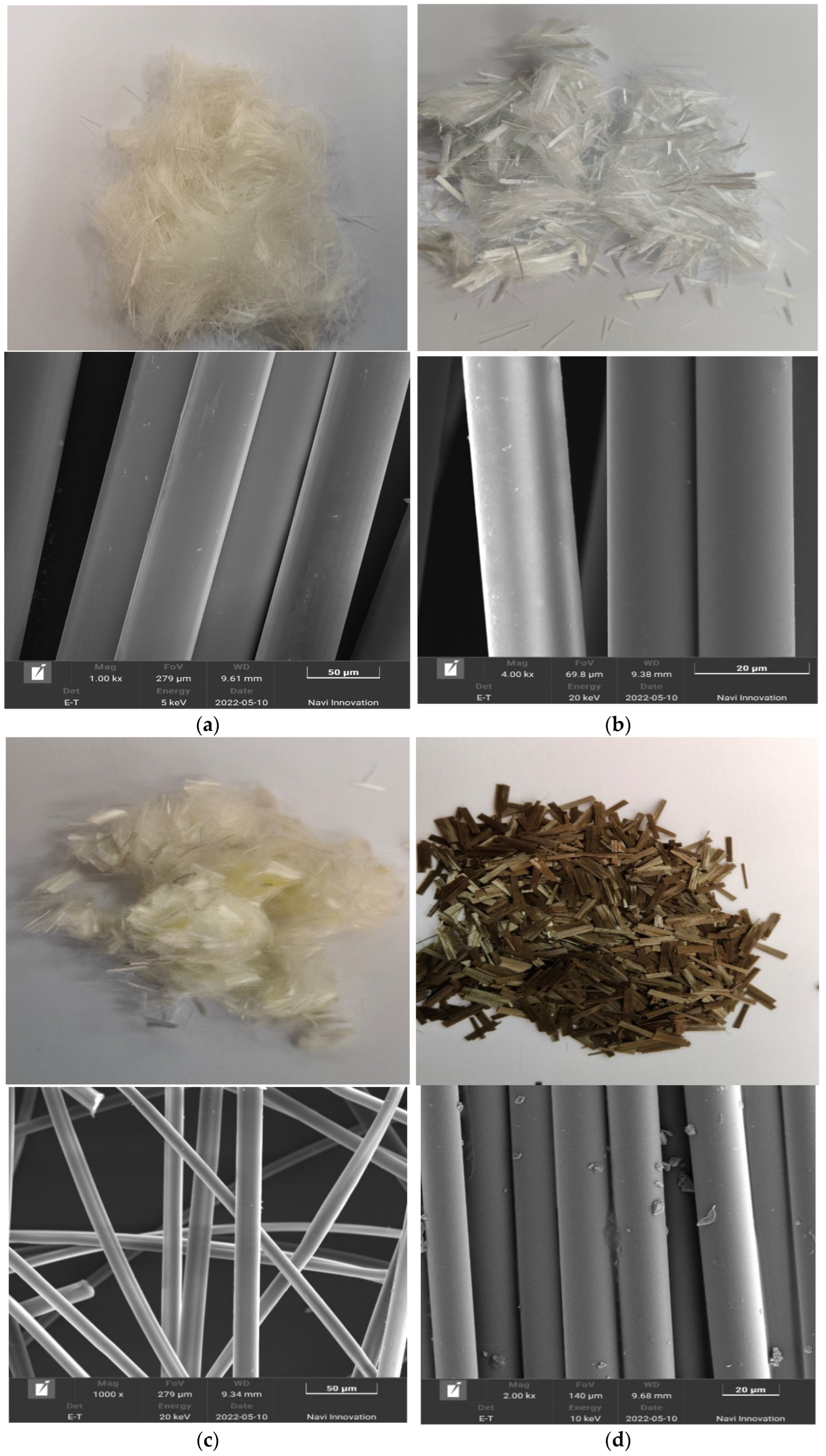
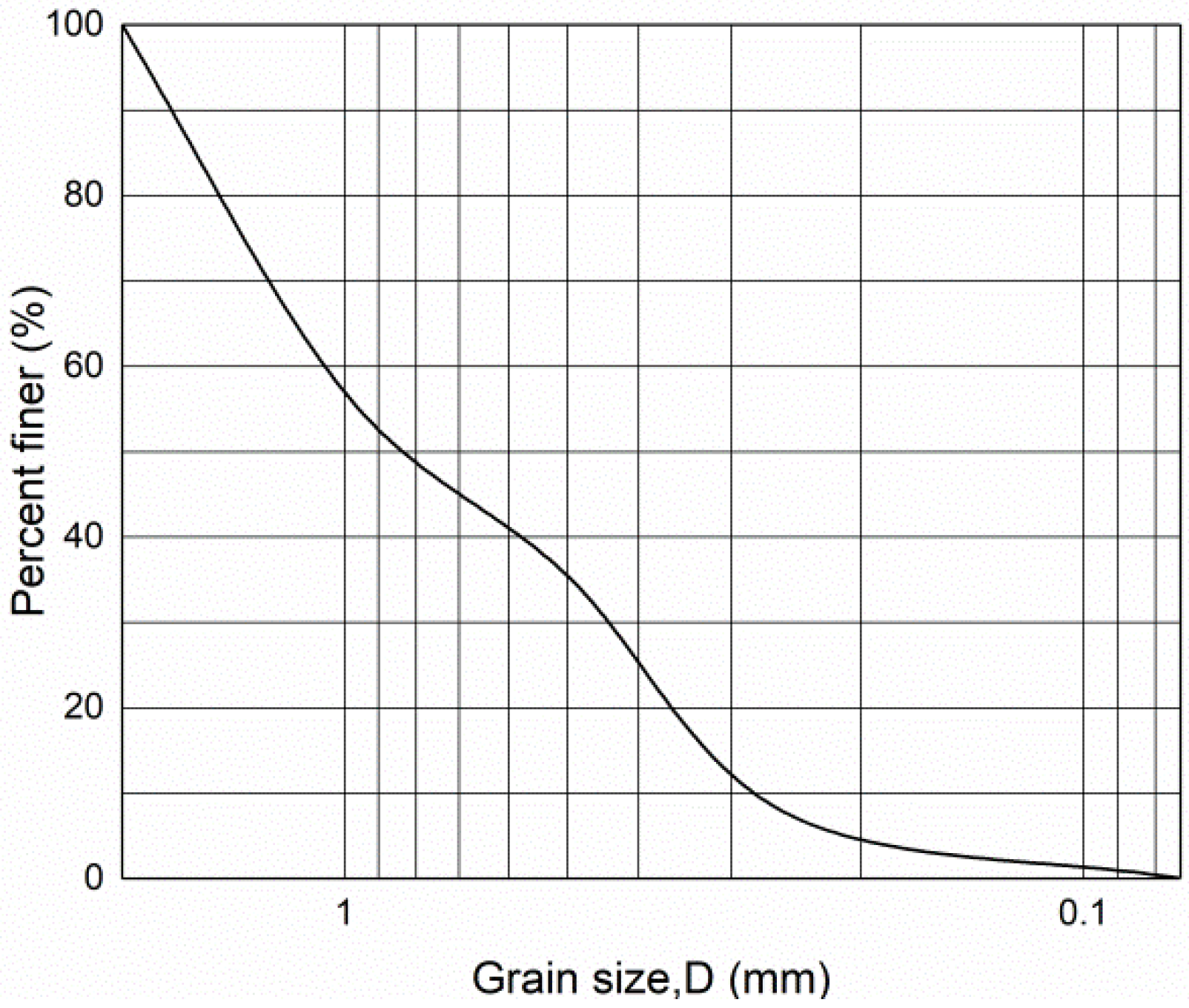

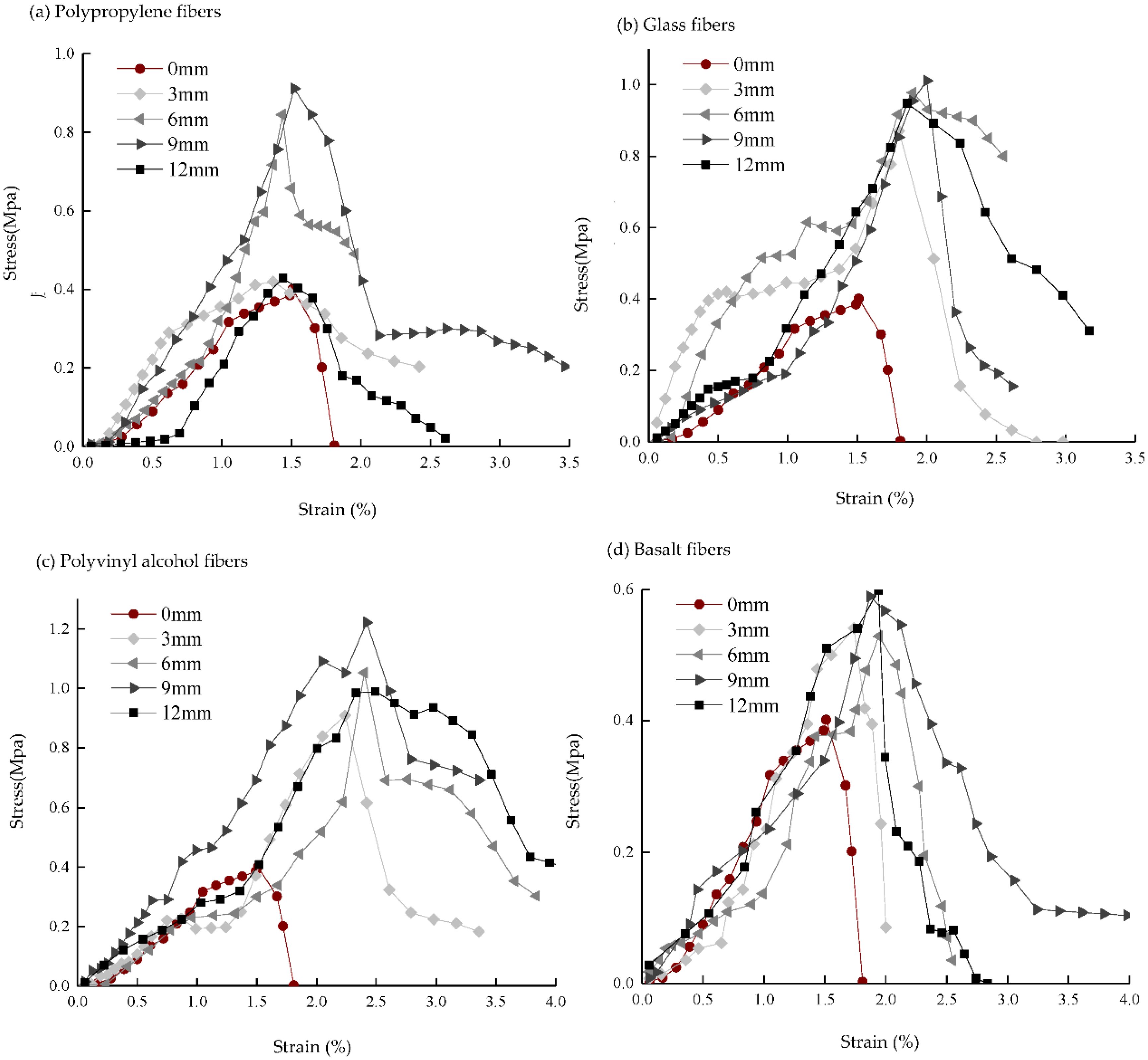
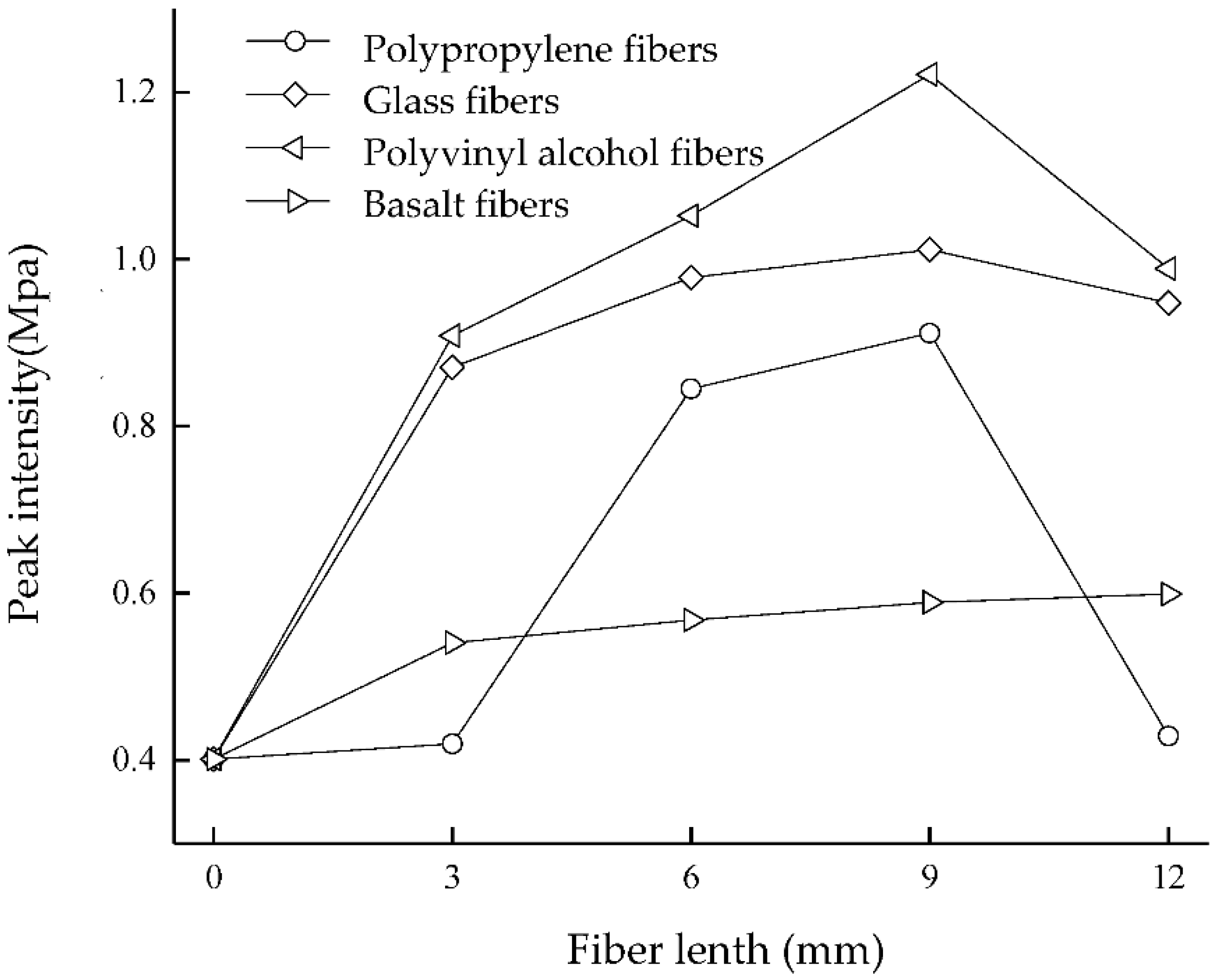
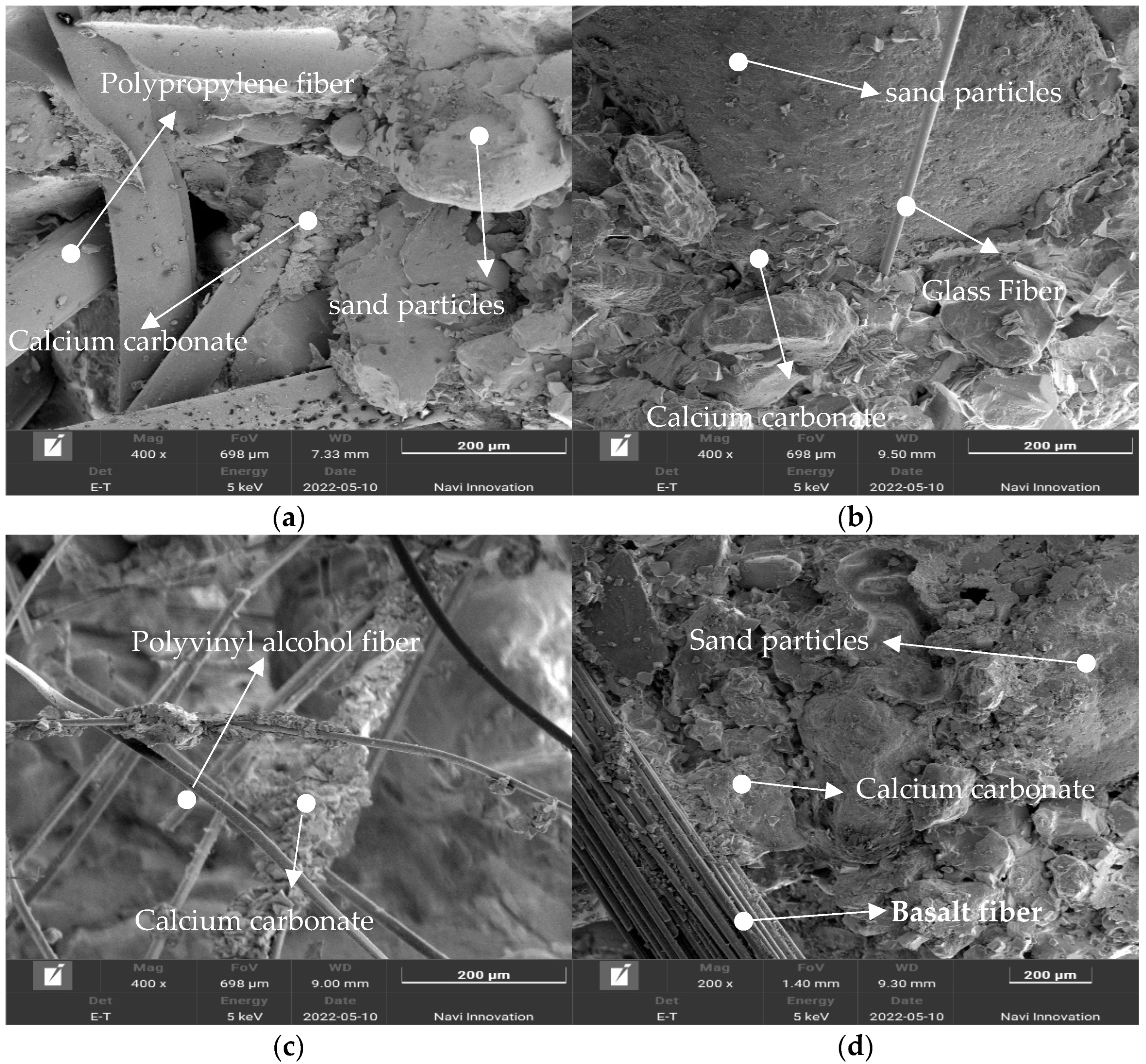
| Type | Density ρ/(g/cm3) | Line Density | Diameter | Tensile Strength/MPa | Elastic Modulus | Breaking Elongation | Breaking Strength |
|---|---|---|---|---|---|---|---|
| /tex | /mm | /MPa | % | N/tex | |||
| polypropylene | 0.91 | —— | 0.025 | ≥500 | ≥3850 | 2.3 | —— |
| glass | 2.699 | 4897 | 0.0174 | 2180 | 8720 | 2.52 | —— |
| polyvinyl alcohol | 1.29 | —— | 0.01509 | 1830 | 40,000 | 6.9 | —— |
| basalt | —— | 2392 | —— | 3836 | 62,000 | 3.0 | 0.69 |
| Fiber Type | Polypropylene Fiber | Glass Fiber | Polyvinyl Alcohol Fiber | Basalt Fiber |
|---|---|---|---|---|
| Chemical composition | Polymers |
Publisher’s Note: MDPI stays neutral with regard to jurisdictional claims in published maps and institutional affiliations. |
© 2022 by the authors. Licensee MDPI, Basel, Switzerland. This article is an open access article distributed under the terms and conditions of the Creative Commons Attribution (CC BY) license (https://creativecommons.org/licenses/by/4.0/).
Share and Cite
Liang, S.; Xiao, X.; Wang, J.; Wang, Y.; Feng, D.; Zhu, C. Influence of Fiber Type and Length on Mechanical Properties of MICP-Treated Sand. Materials 2022, 15, 4017. https://doi.org/10.3390/ma15114017
Liang S, Xiao X, Wang J, Wang Y, Feng D, Zhu C. Influence of Fiber Type and Length on Mechanical Properties of MICP-Treated Sand. Materials. 2022; 15(11):4017. https://doi.org/10.3390/ma15114017
Chicago/Turabian StyleLiang, Shihua, Xueli Xiao, Jie Wang, Yuxing Wang, Deluan Feng, and Chengyuan Zhu. 2022. "Influence of Fiber Type and Length on Mechanical Properties of MICP-Treated Sand" Materials 15, no. 11: 4017. https://doi.org/10.3390/ma15114017
APA StyleLiang, S., Xiao, X., Wang, J., Wang, Y., Feng, D., & Zhu, C. (2022). Influence of Fiber Type and Length on Mechanical Properties of MICP-Treated Sand. Materials, 15(11), 4017. https://doi.org/10.3390/ma15114017





